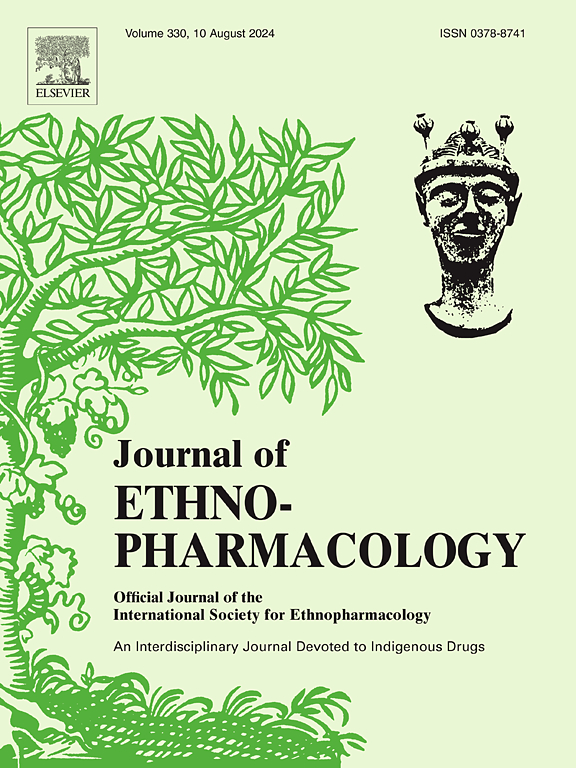Investigation of the antimalarial efficacy of Ilex umbellulata (Wall.) Loes. bark against Plasmodium falciparum using in-vitro whole-cell assays, GC-MS, LC-ToF-MS, and multi-step computational studies
IF 4.8
2区 医学
Q1 CHEMISTRY, MEDICINAL
引用次数: 0
Abstract
Ethnopharmacological relevance
Ilex umbellulata (Wall.) Loes. (Family: Aquifoliaceae), is widely used by different tribes of Southeast Asia as a herbal remedy. The Mizo tribe in India used the stem bark to treat malaria, gland inflammation, inflammation in pregnant women, tonsillitis, dysentery, and for veterinary purposes to treat pig sickness and mange. In Meghalaya, India, the decocted bark is used for digestion. In Thailand, the raw fruit was consumed to relieve stomach aches.
Aim of the study
The study aims to evaluate the in vitro antimalarial efficacy of I. umbellulata bark by screening against chloroquine-sensitive (Pf3D7) and chloroquine-resistant (PfRKL-9) strains of Plasmodium falciparum. Also, the study aims to identify the phytocompounds present in the most active extract and explore the molecular mechanisms against P. falciparum and malaria through in silico approaches.
Material and methods
I. umbellulata bark, collected from Mizoram, India, was taxonomically authenticated by the Botanical Survey of India. Twelve extracts obtained using Soxhlet extraction, decoction, and cold maceration techniques were evaluated for in vitro antimalarial activity against the Pf3D7 and PfRKL-9. Fractions obtained from the active extract were screened for in vitro antimalarial activity. The active extract and fraction were tested for their cytotoxicity using the human embryonic kidney (HEK)-293 cell line and also for their hemolytic activity. The selected extract underwent gas chromatography-mass spectrometry (GC-MS) and liquid chromatography-time of flight (LC-ToF)-MS analyses. Molecular docking, dynamic simulations, and binding free energy calculations were also employed to identify potential targets in P. falciparum. Network pharmacology revealed the malaria pathway genes affected by the phytocompounds of I. umbellulata.
Results
The 80 % MeOH extract (IC50 ≤ 1 μg/ml) and the polar fraction (IC50 ≤ 3 μg/ml) showed the best antimalarial activity. Cytotoxicity and hemolysis assays confirmed the safety and selectivity of the active samples. GC-MS and LC-ToF-MS analyses of the 80 % MeOH extract detected 15 and 10 phytocompounds, respectively. Molecular docking and dynamic simulations showed that the phytocompounds of I. umbellulata formed stable complexes with 10 blood-stage P. falciparum proteins. The network pharmacology study suggests that I. umbellulata may regulate immune responses, reduce inflammation, support early immune signaling, and prevent vascular complications in malaria.
Conclusion
The study identifies 25 phytocompounds in the active extract of I. umbellulata, elucidating their key molecular mechanisms and validating the plant's traditional use, thereby signifying its efficacy and safety for malaria treatment on a global scale.

小黄冬青抗疟作用的研究卫矛。使用体外全细胞检测、GC-MS、LC-ToF-MS和多步计算研究来对抗恶性疟原虫。
民族药理学相关性:小伞形冬青卫矛。(科:水仙科),广泛用于东南亚不同部落的草药治疗。印度米佐部落用树皮茎来治疗疟疾、腺体炎症、孕妇炎症、扁桃体炎、痢疾,并用于兽医治疗猪病和管理。在印度的梅加拉亚邦,熬制的树皮被用来消化。在泰国,人们食用这种生水果来缓解胃痛。研究目的:通过对恶性疟原虫氯喹敏感(Pf3D7)和耐药(PfRKL-9)菌株的筛选,评价伞叶树皮的体外抗疟作用。此外,本研究旨在通过计算机方法鉴定最有效提取物中存在的植物化合物,并探索抗恶性疟原虫和疟疾的分子机制。材料和方法:伞形树皮采自印度米佐拉姆邦,经印度植物学调查分类鉴定。采用索氏提取法、煎煮法和冷浸渍法对12种提取物进行体外抗疟疾活性评价,并对Pf3D7和PfRKL-9进行体外抗疟疾活性评价。从活性提取物中获得的组分进行体外抗疟活性筛选。用人胚胎肾(HEK)-293细胞株检测了活性提取物和活性组分的细胞毒性和溶血活性。采用气相色谱-质谱联用(GC-MS)和液相色谱-飞行时间联用(LC-ToF)进行分析。分子对接、动态模拟和结合自由能计算也被用来识别恶性疟原虫的潜在靶点。网络药理学揭示了伞花植物化合物对疟疾途径基因的影响。结果:80% MeOH提取物(IC50≤1μg/ml)和极性部分(IC50≤3μg/ml)抗疟活性最佳。细胞毒性和溶血实验证实了活性样品的安全性和选择性。80% MeOH提取物的GC-MS和LC-ToF-MS分析分别检测到15种和10种植物化合物。分子对接和动态模拟结果表明,伞形植物化合物与10种血期恶性疟原虫蛋白形成稳定的复合物。网络药理学研究表明,伞形瓢虫可能调节免疫反应,减少炎症,支持早期免疫信号,预防疟疾血管并发症。结论:本研究鉴定了伞形植物活性提取物中的25种植物化合物,阐明了其关键分子机制,验证了该植物的传统用途,从而在全球范围内证明了其治疗疟疾的有效性和安全性。
本文章由计算机程序翻译,如有差异,请以英文原文为准。
求助全文
约1分钟内获得全文
求助全文
来源期刊

Journal of ethnopharmacology
医学-全科医学与补充医学
CiteScore
10.30
自引率
5.60%
发文量
967
审稿时长
77 days
期刊介绍:
The Journal of Ethnopharmacology is dedicated to the exchange of information and understandings about people''s use of plants, fungi, animals, microorganisms and minerals and their biological and pharmacological effects based on the principles established through international conventions. Early people confronted with illness and disease, discovered a wealth of useful therapeutic agents in the plant and animal kingdoms. The empirical knowledge of these medicinal substances and their toxic potential was passed on by oral tradition and sometimes recorded in herbals and other texts on materia medica. Many valuable drugs of today (e.g., atropine, ephedrine, tubocurarine, digoxin, reserpine) came into use through the study of indigenous remedies. Chemists continue to use plant-derived drugs (e.g., morphine, taxol, physostigmine, quinidine, emetine) as prototypes in their attempts to develop more effective and less toxic medicinals.
 求助内容:
求助内容: 应助结果提醒方式:
应助结果提醒方式:


